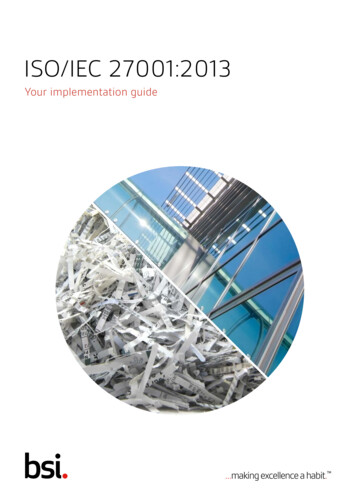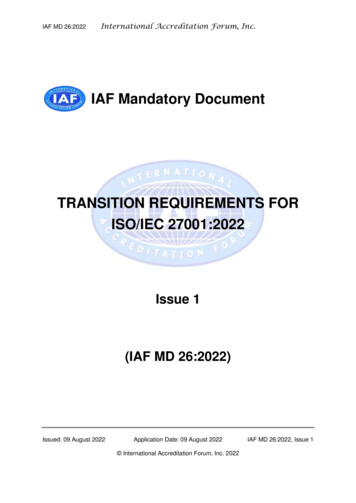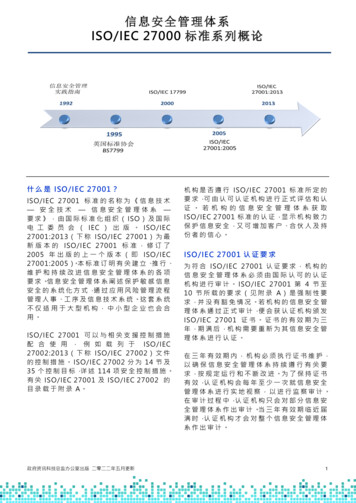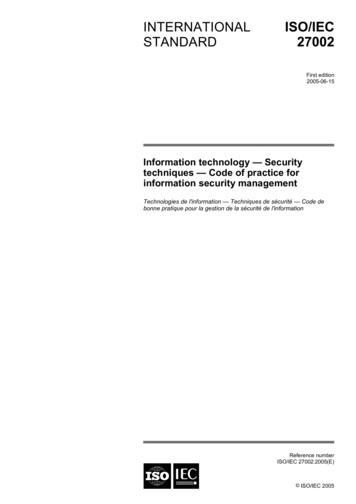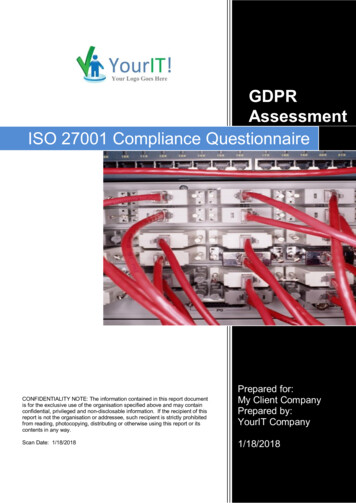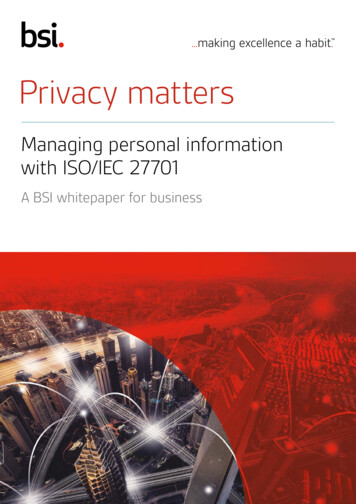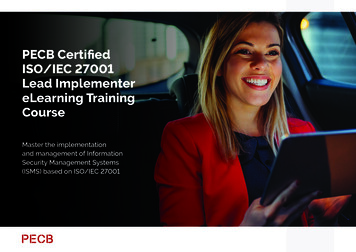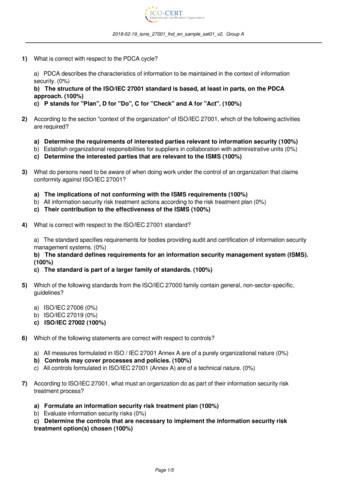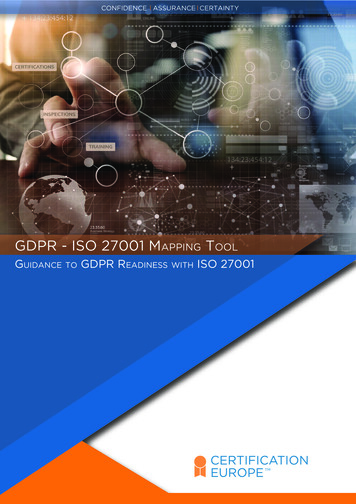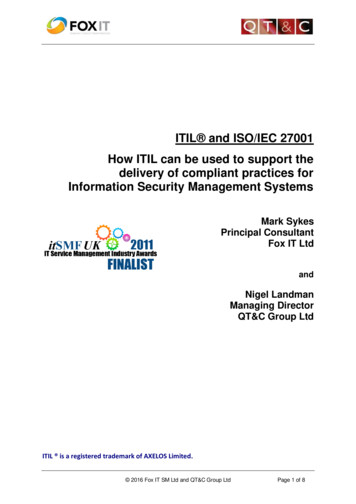
Transcription
ITIL and ISO/IEC 27001How ITIL can be used to support thedelivery of compliant practices forInformation Security Management SystemsMark SykesPrincipal ConsultantFox IT LtdandNigel LandmanManaging DirectorQT&C Group LtdITIL is a registered trademark of AXELOS Limited. 2016 Fox IT SM Ltd and QT&C Group LtdPage 1 of 8
1.IntroductionInformation security or, to be less formal, the protection of an organisations’ information assets, hasseen a serious upsurge in activity, starting in 2007/08. The momentum continues with the majorityof public sector organisations (mirrored to some extent within the commercial sector) now seriouslyconducting third party supplier audits and assessments.What perhaps is less well understood is that work to protect the information asset should have beenin the pipeline well before 2007/08. The upper echelons of an organisation have either failed tograsp the importance of the situation or have simply left this problem to those within theinformation technology (IT) domain. The example of the ever present USB memory stick, pre2007/08, is a perfect example of reacting to a problem that was and regrettably continues to be thecause of misplaced data and information. What plans for change were implemented within theorganisation to allow a USB memory stick to be used as a perfectly sound operational tool, pre2007/08? Anecdotal evidence collected over the years suggests that the simple answer is, none.The protection of the information asset is a corporate responsibility and yet that message has failedto arrive in one piece. How does an organisation go from a policy of implementing ad hoc reactivemeasures to protect information assets to one that is structured, balanced and in-tune withoperational requirements? The tools have always been available via British and International codesof practice, guidelines, and requirements (standards). Additional tools, within the UK, in the form ofinformation assurance maturity models for the public sector (and perfectly valid for the commercialsector) have come on stream via the Communications Electronic Security Group (CESG). It thereforebegs the question; why is there so much angst when highly skilled and experienced individualsattempt to put in place preventive measures to protect the information asset? Senior officers shouldalways remember that implementing an IT solution is not always the first port of call.This paper highlights procedural techniques that are utilised within the Service Management domainthat could be used to roll-out positive and workable information governance, security, and assurance.The notion, for example, of change and the procedures adopted within Change Management can andshould be used to positive affect throughout the organisation. Perhaps the beginnings of a unifiedtheory are beginning to form, the outcome of which can only be a positive step forward.Indeed, this paper will help show that many of the existing Service Management processes andpractices that may already exist within an organisation can be used to good effect for satisfying partsof the ISO/IEC 27001 international standard. 2016 Fox IT SM Ltd and QT&C Group LtdPage 2 of 8
2.What is ISO/IEC 27001The full name of the ISO/IEC 27001 standard is “ISO/IEC 27001:2005 - Information technology Security techniques - Information security management systems – Requirements”. It is the onlyauditable international standard which defines the requirements for an Information SecurityManagement System (ISMS).The standard is designed to ensure the selection of adequate and proportionate security controls;these controls help protect information assets and gives confidence to stakeholders such ascustomers. Individual controls are neither specified nor mandated; these are dependent on the sizeand type of organisation, and what is applicable to their business.The standard itself adopts a process approach for establishing, implementing, operating, monitoring,reviewing, maintaining, and improving the ISMS. ISO/IEC 27001 is intended to be used in conjunctionwith ISO/IEC 27002, the “Code of Practice for Information Security Management”, which listssecurity control objectives and recommends a range of specific security controls. Organisations thatimplement an Information Security Management System in accordance with the advice provided inISO/IEC 27002 are likely to meet the requirements of ISO/IEC 27001 for certification.The ISO/IEC 27001 standard is one of the growing ‘family’ of ISO/IEC 27000 series of standards andwas originally published in October 2005. These standards are derived from BS 7799 and providegenerally accepted good practice guidance on Information Security Management Systems designedto protect the confidentiality, integrity and availability of the information content and informationsystems.3.Control Objectives and ControlsOne of the key aspects of ISO/IEC 27001 is “Annex A – Control objectives and controls”. This tablelists the 11 control areas of the standard, their associated control objectives (39 in total) and the 133controls themselves. Controls are required to be put in place so that an organisation can manage therisks to their information security, and they are implemented relative to the greater business risks ofthe organisation as a whole.The control objectives and their controls form the Code of Practice (ISO/IEC 27002) and it is herewhere ITIL can play an important part in supporting the delivery of many aspects of the listedcontrols.It should be noted though, that ITIL won’t ‘do it all’ if you are seeking to obtain ISO/IEC 27001certification, but it will certainly ease the path to achieving that objective. Indeed, for thoseorganisations already operating a mature ITIL framework, they will find that many of their processesand activities that are already in place will make implementing the information security controls thatmuch easier, and quite likely for less cost and much quicker than would otherwise be the case. 2016 Fox IT SM Ltd and QT&C Group LtdPage 3 of 8
4.How can ITIL help?Fox IT and QT&C Group Ltd have performed a mapping exercise that looked at each of the 11information security control areas. The individual control objectives and controls were reviewed, theassociated implementation recommendations for each control were assessed, and connections werebuilt to the relevant ITIL v3 processes that would support delivery of each individual control – eitherfully or in part (see examples in Section 5).The exercise produced the following number of relationships between ISO/IEC 27002 and ITIL:AreaNumber of relationshipsA.5 Security Policy2A.6 Organisation of Information Security22A.7 Asset Management2A.8 Human Resources Security10A.9 Physical and Environmental Security13A.10 Communications and Operations Management32A.11 Access Control12A.12 Information Systems Acquisition, Development andMaintenance12A.13 Information Security Incident Management7A.14 Business Continuity Management5A.15 CompliancenilAs you can see from the above numbers, many of the controls and their associated implementationrecommendations can be supported by processes and activities that form part of the ITIL framework;some of these are explored further in Section 5.The extract below, taken from the relationship matrix, shows a number of the Service Transitionprocesses within ITIL and their direct connection to the controls within ISO/IEC 27002.In the following section, a number of specific examples will be reviewed, to show exactly where andhow ITIL can be used to support the delivery of individual controls. 2016 Fox IT SM Ltd and QT&C Group LtdPage 4 of 8
5.ITIL and ISO27002 Controls5.1.Change ManagementAs can be seen in the extract of the relationship matrix above, six of the eleven control areas showdirect relationships to Change Management. A.6.1 Internal Organisation, within A.6 Organisation ofInformation Security, has the following control: A6.1.4 - Authorisation process for informationprocessing facilities.The control here is for ‘Management authorisation process for new information processing facilities,to be defined and implemented’. Fox IT recommends that where authorisation is required, then achange request should be raised and the Change Management process followed.Another relationship can be found in A.9 Physical and Environmental Security, more specificallyA.9.2 Equipment Security. The control for A9.2.6 - Secure disposal or re-use of equipment states‘All items of equipment incorporating storage media should be checked to ensure that any sensitivedata and licensed software has been removed or securely overwritten prior to disposal’. Therecommendation for this control is that devices containing information need to be destroyedphysically and/or erased with appropriate tools to prevent any reuse of the data; also re-usedequipment needs careful erasure to ensure no data is readable.To support this activity, and to ensure that the requirements are successfully fulfilled, it isrecommended that a change request be raised and hence the Change Management process will beinitiated – this will ensure that the Information Asset Owner (IAO) receives formal notification. TheIAO will advise on what action needs to be performed – which may include performing an additionalrisk assessment.Similarly, A9.2.7 - Removal of property states ‘Equipment, information or software should not betaken off-site without prior authorisation’. This is another clear example where a suitableauthorisation procedure is required, together with the appropriate level of authorisation (i.e. via theChange Management process). A9.2.7 also has an interface to Service Asset & ConfigurationManagement as the equipment should be recorded as being off-site, using the configurationmanagement database (CMDB).5.2.Access ControlLooking elsewhere away from Service Transition, A.11 Access Control is broken down into sevencontrol objectives, the majority of which can be found to have relationships with aspects of ITIL. Aswith all of the controls, ITIL doesn’t necessarily provide an all-encompassing answer (or answers), butITIL processes can support and deliver many of the individual controls, or parts of the controls, thatare required by the ISO/IEC 27002 Code of Practice.The ITIL Service Operation book has a process called Access Management, and it is relatively easy torelate this process to A.11 Access Control. One of the seven control objectives of this standard isA.11.2 User Access Management, which in turn is broken down into the following four segments: A11.2.1 User registration A11.2.2 Privilege management A11.2.3 User password management A11.2.4 Review of user access rights 2016 Fox IT SM Ltd and QT&C Group LtdPage 5 of 8
When looking at the specific control statements for each of these, and their associatedimplementation recommendations, it is quite simple to see that the Access Management processwithin ITIL supports the delivery of the above – and, providing the appropriate Access Policy is inplace, will go a long way to satisfying the controls that are required.To further support the relationship between ITIL and the international standard, one of theimplementation recommendations is that changes are logged for any amendments to user accessrights. This provides a clear and distinct relationship to the Change Management process within ITIL– indeed, this aspect for many organisations will already be being performed.5.3.Multiple relationshipsAnother good example of how the implementation of information security controls can be assistedby the existence of a mature ITIL framework is the control objective A.6.2 External Parties within A.6Organisation of Information Security. The third control within this objective is A6.2.3 - Addressingsecurity in third party agreements.The implementation advice for this control covers many areas, but can be directly linked to thefollowing ITIL processes: “Clear process for change management” - Change Management. “Service continuity process” - IT Service Continuity Management. “Problem resolution process” - Problem Management. “Product or service descriptions” - Service Catalogue Management. “Clear reporting process” - Service Reporting. “Service targets and other contractual responsibilities such as those found in contracts” and“Conditions of early termination/renegotiation of agreements” - Supplier Management.Indeed, taking the whole of A.6.2 External Parties there are also links to Access Management, RiskManagement and Service Level Management.6.Other StandardsThe mapping exercise that was performed highlighted relationships across all five ITIL books, andmore specifically for the majority of processes within those books. Supplier Management is one of anumber of processes that was not in the original core ITIL v2 books of Service Support and ServiceDelivery, but it is a distinct element of ISO/IEC 20000, the international standard for IT ServiceManagement.Although the process is now included within the Service Design book, many organisations will haveimplemented this process as part of their activities for achieving ISO/IEC 20000 certification.If this is the case, then look at how your existing process and underlying activities can support therelevant information security controls as listed within ISO/IEC 27002; and not just for SupplierManagement either, review all of your processes and see where there are synergies that can bemaximised. The same can also be said for other standards such as “ISO 9001 – Quality managementsystems” and “BS 25999 – Business continuity management”, and no doubt many others. 2016 Fox IT SM Ltd and QT&C Group LtdPage 6 of 8
7.SummaryAs we have seen, there are many relationships between ITIL and ISO/IEC 27001 (including ISO/IEC27002). Having a mature Service Management framework will assist greatly in achieving compliantcontrols that support an Information Security Management System.It is important to remember that there are many aspects of ISO/IEC 27001 where ITIL will not providethe ‘answers’. But what ITIL will do is to assist you in many of the control aspects required by theinternational standard. So make a start by looking at your current Service Management frameworkand look for opportunities to utilise existing processes and practices as part of the security controlsand ISMS that must be implemented.As the saying goes, ‘no need to re-invent the wheel’. For example, if your existing ChangeManagement process can support the information security controls, then use it. Okay, it may needadapting a little, but that will likely be a lot more effective (and certainly more efficient) than startingfrom scratch. 2016 Fox IT SM Ltd and QT&C Group LtdPage 7 of 8
8.ITIL and ISO/IEC 27001 Relationship Matrix 2016 Fox IT SM Ltd and QT&C Group LtdPage 8 of 8
What is ISO/IEC 27001 The full name of the ISO/IEC 27001 standard is "ISO/IEC 27001:2005 - Information technology - Security techniques - Information security management systems - Requirements". It is the only auditable international standard which defines the requirements for an Information Security Management System (ISMS).

